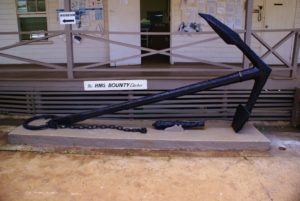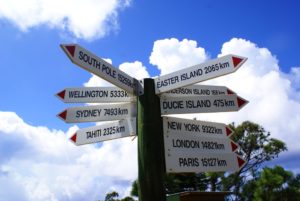
Pitcairn Island boasts some dramatic seascapes.
When my daughter, Lia, and her partner, Mike, traipsed into the wilds of North Carolina last August for an unobstructed view of the total eclipse of the sun, they also ventured into the rising realm of Astro Tourism — along with thousands of other Americans who journeyed near and far to find the ideal locales to witness that extraordinary celestial event.
Having just had cataract surgery, I wasn’t among them, alas, and here in Tucson the sky barely darkened during our partial eclipse, which was hundreds of miles south of the band of totality that swept across the U.S.
I was able to view the “super blue blood moon” eclipse on January 31, a lunar event that had not occurred in the United States since 1866. But that was visible right here in my front yard, and all it required was walking a few feet outdoors in the comfort of my robe at 6 a.m. It wasn’t even chilly.
So I can’t really call myself an Astro Tourist yet. That’s reserved for the dedicated people who travel to the far corners of the globe to seek out phenomena like solar eclipses, meteor showers, the Northern (and Southern) Lights, and rare conjunctions of planets.
Special Astro-themed cruises have sailed to the southern Caribbean, the coast of Australia, and other spots on the high seas to assure the best views possible.
On land, just three places on earth — remote areas of Chile, New Zealand, and a part of the Gila National Forest of New Mexico — have been designated Dark Sky Sanctuaries, the darkest of the dark.
And now the tiny British overseas territory of Pitcairn Island wants to get in on the act.

A stop at the local museum is a must.
The Mutineer Legacy
Everyone knows the story of Pitcairn Island, where in 1790 Fletcher Christian and his band of nine mutineers from the HMS Bounty landed after sending Captain Bly and his loyalists off in a lifeboat in the middle of the South Pacific following a stop to load breadfruit on Tahiti. The grim life of a British sailor (compounded by the sadistic Bly) paled before the sensual delights of Polynesia, and the world’s most infamous mutiny was born.
Christian and company, including several Tahitian women, settled on Pitcairn, and most of the island’s 50 current residents — forming the least populous official jurisdiction on earth — can trace their lineage back to them.
Pitcairn gives new meaning to the word “remote.” It’s situated about halfway between New Zealand and the coast of Chile, about 300 miles from the nearest populated island, and has no airport. For some, it’s the ultimate bucket list destination.
It can currently be reached by a number of cruise ships making one or two-day stops — Hapag-Lloyd, Crystal, and National Geographic cruise lines among them — or, for the more dedicated, by boarding cargo ships that make the periodic round-trip journey from French Polynesia to drop off supplies.

The Claymore makes its deliveries.
For about US $3,600 per passenger, you can book a berth on the MV Claymore II, which sails irregularly from Mangareva in French Polynesia and returns either four or 11 days later, offering plenty of time to soak up the Pitcairn atmosphere and probably meet most everyone who lives there, should you wish to.
Accommodations on the island are primarily full-board homestays or self-catering private rentals. For local cuisine, think fish and breadfruit.
High Hopes for Astro Tourism
Perhaps because of wariness passed down from the mutineers to their descendants — or simply their isolation, which has bred suspicion of the outside world — Pitcairn has had a prior reputation for not being the most welcoming place for visitors, although they now have a nice website dedicated to eco-tourism and are even encouraging immigration to help refresh their aging population.
However, serious issues linger that date from child abuse and sexual assault cases resulting in the conviction of several islanders in 2004. More recently, in 2016, the island’s mayor was convicted of possessing hard-core child pornography, which was said to shock even previous local sex offenders. Not the stuff that will attract young families to set up households in a truly insular environment.
But, according to George Taylor, editor in chief of eTurboNews.com, Pitcairn’s residents (consisting of four main families) have now seen an opportunity in the heavens and are applying to become the world’s fourth Dark Sky Sanctuary in 2018, with the aim of attracting the growing body of Astro Tourists.
“Pitcairn has amazing dark skyscapes,” raved Pitcairn travel coordinator Heather Menzies when making the announcement. “We aim to curate a world-class night sky-viewing experience on Pitcairn. Being such a pristine and remote island, our natural amphitheatre will provide an ideal location for intrepid Astro visitors.”
As Taylor puts it, “Pitcairn’s application will be a strong one,” citing the island’s crystal clear oceans and night skies, with a volcanic landscape offering excellent vantage points for viewing the Milky Way and other galaxies far, far away.

Signposts suggest Pitcairn’s remoteness.
To further their case, Taylor writes, the islanders have invited John Hearnshaw, emeritus professor of astronomy at England’s University of Canterbury, to visit “and assess [Pitcairn’s] suitability for Astro Tourism as it relates to the training of night-sky guides, location scouting, and light metering.”
Guides will be trained to deliver expert info on “planets, stars, nebulae and galaxies, lunar and solar eclipses, timekeeping in astronomy, black holes, quasars, and cosmology.”
Pitcairn already has the brand, with high name recognition from numerous books and movies recounting the immortal tale of the Bounty.
Now, island residents hope they can begin to clean up more recent bad acts and notoriety– and maybe import some new blood in the form of guides — with crash courses in astronomy.
I’m willing to applaud their initiative, assuming they really have turned the corner. And I’d hate to see the romantic story of Fletcher Christian end as just a footnote in history — with Pitcairn again reverting to being just an uninhabited rock in the middle of the ocean.
Photo credits: Pitcairn Tourism.
Special Notes: If you’re interested in taking up astronomy as a hobby, be sure to check out “The Ultimate Beginner’s Guide to Astronomy” on HobbyHelp.com. It’s a terrific resource for potential Astro Tourists or anyone who wants to pick up a telescope and observe the majesty of the night sky.
And here’s another great resource: How to Get Started with Astronomy on a Shoestring Budget. It lays out a plan of action for taking up astronomy as a hobby in simple, easy to read style.












Leave a Reply